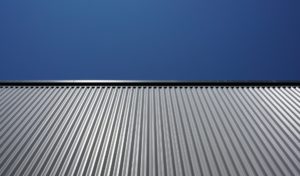Complete Comparison of Standing Seam vs. Corrugated Metal Roofs
Published on Thursday July 8, 2021
Standing seam and corrugated metal roofs are two popular metal roofing types. Both offer all the benefits of metal roofs—including durability, eco-friendliness, and energy efficiency.
But while both roofing types are excellent choices, there are many key differences to consider when it comes to performance and style.
Read on to learn more about standing seam metal roofs versus corrugated metal roofs, their pros and cons, differences, and how to decide which type is right for you.
What is a Standing Seam Metal Roof?

A standing seam metal roof is a type of metal roofing panel that locks together with the other metal panels using a concealed fastener. This concealed fastener has vertical legs (where the fastener loops together underneath) and a wide flat area of panel between each leg.
Standing seam metal roofs can also be recognized by having a raised (or standing) seam. These rise up over the flat area of the panel in a long line.
Standing seam technology can be used on metal roofs, but it can also be used on metal walls, though standing seam metal roofs are much more common.
The most notable thing to keep in mind when it comes to standing seam metal roofs is that the fastener is hidden under that raised seam.
The panel can be attached with a clip, or it can be directly attached to the roof decking underneath the standing seam fastener. Either way, the fasteners are hidden.
Pros
When it comes to standing seam metal roofs versus corrugated roofs, standing seam roofs have a lot of pros.
Less Likely to Leak. Standing seam metal roofs are less likely to leak because of how the fastener system is designed. The way the fasteners lock together and are hidden under the seam helps make them less likely to leak than many other roofing types.
This is exceptionally helpful since many roof leaks can be hard to find.
There Are No Exposed Fasteners. This is one of the most beneficial things about standing seam metal roofs. None of the fasteners are visible at the surface of the roof. While this might not seem like a big deal, it actually is because it means none of the fasteners are exposed to moisture, wind, UV, or other elements that lead to wear and tear—even failure—over time.
This means the fasteners will last longer and your roof won’t need as much maintenance as the years go by.
It’s an Engineered System Tested to Perform to High Standards. Standing seam metal roofs are made with a technology that requires testing. Standing seam roof systems get tested to high standards implemented by industry leaders.
That means that all standing seam systems are engineered to adhere to testing standards for air leakage, water penetration, impact resistance, wind uplift, and fire or combustion resistance. When you get a standing seam roof, you know the materials have been built to last.
There is Allowance for Thermal Movement. Some metal roofing types restrict the natural expansion and contraction process of metal panels. This can lead to many problems, including fastener withdrawal, noise, and other issues.
A standing seam metal roof, however, allows for the panels to expand and contract since they aren’t double pinned. This can help your roof perform better over time.
Cons
While standing seam metal roofs have a lot of pros, they also have a lot of cons, which are important to consider when comparing a standing seam versus a corrugated metal roof.
They are Expensive. When it comes to choosing any type of roof, the price tag can play a big role in determining if it’s the right choice for you. A big drawback to standing seam metal roofs is that they can be much more expensive than many other roofing types.
It’s not the most expensive metal roofing type (metal shingles and stamped metal materials are often more expensive), but it’s on the expensive side depending on the size and complexity of your roof.
They Require Labor-Intensive Installation. For metal roofs with exposed fastener systems, the installation process is simple: lay down the material on the roofing deck and either nail or screw it down.
For standing seam metal roofs with hidden fasteners, the process is complicated and labor-intensive. The metal panels will need to be formed using an on-site roll or by being purchased from regional manufacturers.
The clips will need proper spacing and fastening. For a snap-lock system, the panels will need to be aligned and snapped together, but for a mechanically seamed system, the panels will need to be aligned and seamed together.
Then all the necessary slits must be accounted for according to the size and complexity of your roof and the flashing areas.
What is a Corrugated Metal Roof?

A corrugated metal roof is a roll-formed piece of metal sheet that’s formed into a metal roofing panel, and it’s typically rounded and wavy.
The term “corrugated” can be a tricky one since people in the roofing industry use it to refer to the wavy, “S” shaped roofing panel, or anything rounded and wavy but not squared off and boxy.
The term itself, however, means any type of metal that has grooves and ridges (which would include squared-off and boxy shapes).
Corrugated metal roofing is a lightweight, low-cost, but durable roofing type that is easy to install and makes for a great replacement over typical asphalt shingles. Corrugated metal roofing is used in both commercial and residential buildings, and it can be used as metal roofing or metal walls.
Pros
Most Affordable Metal Roof Type. Corrugated metal roofing panels are the most affordable metal roofing type on the market today. They are comparable in price to asphalt shingles and tend to cost about 50 percent to that of standing seam metal roofs.
The size and complexity of your roof will determine the ultimate cost of the installation.
Easy Installation. Corrugated metal roofing panels are much easier to install than standing seam roofs, and they require fewer skills and less labor. Installation costs for corrugated metal roofs tend to be about 50 percent to that of standing seam metal roofs.
Cons
More Maintenance is Required. Most metal roofing types don’t require a lot of maintenance—other than a yearly inspection to catch any problems before they become severe. That being said, corrugated metal roofs are an exposed fastener roofing type, meaning their fasteners are exposed to the elements (unlike standing seam metal roofs which have hidden, protected fasteners).
This means a corrugated metal roof will naturally require more maintenance and repairs than a standing seam metal roof in the long run.
Less Weather-tightness. Corrugated metal roofs have less water-tightness than standing seam metal roofs, which are amazing at preventing leaks and are tested to maintain high standards.
Since corrugated metal roofs have exposed fasteners, there are thousands of little fasteners penetrating the roof panel—all of which are necessary to hold the roof in place, but all of which are an opportunity for moisture to penetrate.
They Tend to be Thin. The higher the metal gauge on a metal panel, the thinner the material is. Corrugated panels tend to be made with a 29-26 gauge metal while standing seam is made with 22-24 gauge metal.
That means corrugated metal panels are thinner and less able to withstand severe weather such as high winds or hailstorms.
They Suit Limited Roof Slopes. For corrugated metal roofs to be effective, they cannot be used on a low slope roof. They require a minimum roof slope of 3 inches in 12 inches, so if your roof has a lower slope, you cannot use corrugated metal roofing panels.
What are the Differences Between Standing Seam and Corrugated Metal Roofs?
Cost
The cost comparison of standing seam and corrugated metal roofs is pretty substantial. While the ultimate cost depends on the size and complexity of your roof, corrugated metal roofs compare in price to asphalt shingle roofing and standing seam metal roofs cost up to twice as much as corrugated metal roofs.
Installation
Standing seam metal roofs are very complicated to install and can be a labor-intensive process. Their hidden fasteners make it a weather-tight roof, but a skilled hand by a professional roofing contractor is required for the job to be properly done.
Corrugated metal roofs have exposed fasteners, and while this makes the installation process much easier, faster, and cheaper (the roofing panels can be quickly screwed on and don’t have a complicated standing seam), they are more prone to leaks due to this type of installation.
Durability
All metal roofing types are well-known for their durability (as long as they are properly maintained, along with the gutter system). Metal roofs hold up to weather and time much better than many other roofing types, especially asphalt shingles. That being said, not all roofing types are created equal and some are much more durable than others.
Standing seam metal roofs have a hidden fastener allowing them to be more durable and less prone to leaks, rust, and uplift from high winds than corrugated metal roofs.
Appearance
Standing seam metal roofs have a smooth, modern design. They’re flat except for the long, vertical standing seams that run up and down the roof, and they can come in a variety of colors. Corrugated metal roofs are wavy and will have exposed fasteners. They can also come in a variety of colors.
How to Decide Which is Right For You
It’s important to fully consider the pros and cons of standing seam metal roofs and corrugated metal roofs to help in your decision about which panel is best for your roof. If you’ve considered these and still aren’t sure which roofing type is best for you, here are our suggestions:
Standing seam metal roofs are best for someone who:
- Lives in an area with severe storms and needs a durable roof that will hold up
- Wants the most weather-tight metal roofing panel and has the budget for it
- Wants a low-maintenance roof
- Needs a roof type that will work with a low roof slope
- Wants a sleek, modern design for their roof
Corrugated metal roofs are best for someone who:
- Has a strict budget and wants to spend less money
- Has a minimum roof slope of 3 inches in 12 inches
- Wants a quick, easy installation process
- Wants a wavy roof and not one that’s flat
Contact Long Home Products for a New Metal Roof
Now that you know the key differences between standing seam versus corrugated metal roofs, you’re better equipped to decide on what roofing type is best for your home.
If you have more questions about these roofing types or the installation process, or are looking to have a metal roof installed, don’t hesitate to reach out to our experts at Long Home Products.
Interested in Long Home Products?
See our special offers now.








